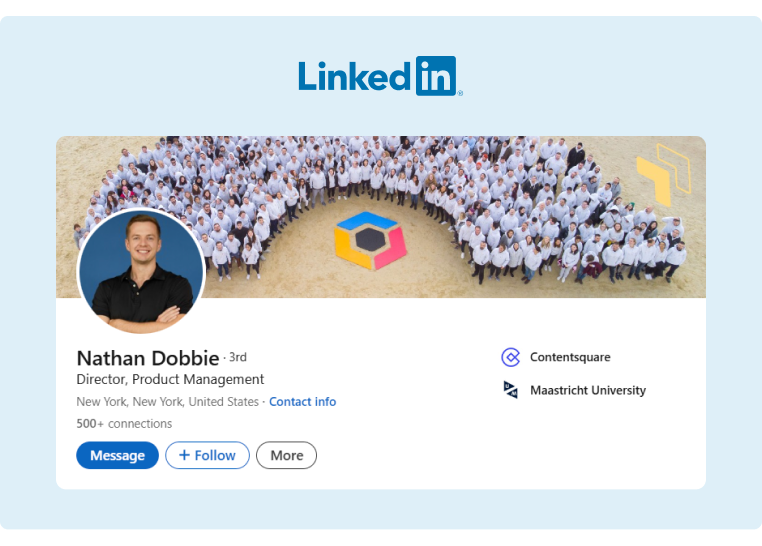How To Optimize Your LinkedIn Profile
Have you ever wondered why some LinkedIn profiles attract lucrative opportunities while others blend into the background?
It takes more than regular posting — an optimized profile empowers your brand and opens doors to valuable collaborations.
This blog post will provide you with sharp, actionable tips to transform your LinkedIn profile into an opportunity grabbing machine.
Let’s dive in.
What Is an Optimized LinkedIn Profile?
An optimized LinkedIn profile is a strategic asset that showcases your professional brand, highlights your expertise, and connects you with valuable opportunities. It is comprehensive, engaging, and tailored to attract the right audience.
Key elements include:
-
Professional Photo: High-quality headshot conveying approachability and competence.
-
Compelling Headline: Descriptive headline explaining your role and value.
-
Engaging Summary: Well-crafted summary highlighting achievements and goals.
-
Detailed Experience: Comprehensive descriptions of work experience, emphasizing accomplishments.
-
Skills and Endorsements: Relevant skills endorsed by connections.
-
Recommendations: Testimonials from colleagues and clients validating your capabilities.
-
Customized URL: Personalized LinkedIn URL for better branding and visibility.
-
Media and Projects: Visuals, documents, and links showcasing your work and achievements.
Why Should You Optimize Your LinkedIn Profile?
Simple: it gives you a competitive edge on a crowded platform. B2B tech marketers, in particular, state that LinkedIn brings the best value for their organization due to its:
-
Visibility and Reach: LinkedIn’s algorithm favors detailed profiles, increasing your chances of appearing in search results.
-
Enhanced Engagement: An engaging profile attracts more views and interactions, leading to valuable connections and opportunities.
-
Networking Opportunities: It attracts industry leaders and collaborators, opening doors to speaking engagements, consulting gigs, and collaborative projects.
-
Brand Building: Consistent presentation of your skills builds a strong personal brand in the competitive B2B tech sector. In fact, research shows that brands seen on LinkedIn are perceived as more professional, more respectable, and higher quality.
-
Lead Generation: An optimized profile attracts potential clients and partners, generating leads and driving business growth.
Download our LinkedIn Profile Optimization Cheat Sheet to help you optimize your profile.
LinkedIn Profile Optimization Basics
Before we get into the nitty-gritty details, let’s cover the basics first:
Choose a Strong Profile Picture
Your profile picture is your first impression, so make it count. Here are some strategic tips directly from LinkedIn:
- Use High-Resolution: Recommended pixel size is between 400 (w) x 400 (h) pixels and 7680 (w) x 4320 (h) pixels.
- Remove Distractions: Use a clean, neutral background to keep the focus on your face (e.g., avoid poles or vertical elements that take your eyes away from the face).
- Strategic Cropping: Crop your image to focus on your face; it should take up at least 60% of the frame.
- Don’t Take a Selfie: Get someone else to take the picture, or use a tripod/stand.
- Lighting and Clarity: Use natural lighting and high resolution to ensure your photo is clear and professional.

Source: Nathan Dobbie
Utilize the Background Photo
Your background photo captures the most space. Here are some ways to optimize it:
- Brand Alignment: Choose an image that aligns with your industry or personal brand (e.g., sleek modern background for tech industry).
- Call to Action: Add text overlays with a CTA or a tagline.
- Seasonal Updates: Regularly update your background to reflect current projects, products, or achievements.
- Your Value Proposition: Your background photo should help someone understand the value you bring to the table or how you can help them.

Source: Mark P. Jung
Be Smart With Your Profile Headline
Your headline is more than your title. A good formula to use is “I help X achieve Y through Z.” Here are three variations you can use:
-
Value Proposition: Highlight the value you bring to your role or industry. Instead of "Software Engineer," try "Fintech Software Engineer Specializing in Scalable Solutions."
-
Target Audience: Speak directly to your target audience. For instance, "Helping SaaS Companies Scale Through Content Marketing Strategies."
-
Problem-Solver Angle: Frame your headline to show how you solve problems. For example, "Marketing Strategist Helping Tech Startups Achieve Exponential Growth."

Source: Joe Zappa
Write a Compelling About Section
Many people mistake this section for a resume (and a place to brag). List your skills and achievements, but tell your story, use authentic language that reflects your brand and highlights unique contributions authentically.
Pro Tips:
-
Keep it concise — this isn’t an autobiography.
-
Include industry-relevant keywords.
-
Highlight specific, measurable accomplishments.
-
Add a CTA to encourage people to reach out.
-
Use short, punchy sentences.
-
When possible, lead with metrics.

Source: Justina Perro
Fill Out Your Work Experience
This is the place for your resume. The best optimized profiles showcase not just what you did, but the impact that you made.
-
Focus On What You Achieved. Instead of stating what you were tasked with, use "Spearheaded a project that reduced operational costs by 20%."
-
Provide Context for Your Achievements. Instead of "Led a team," use "Led a cross-functional team of 10 to develop a new product line that generated $2M in annual revenue."

Source: Kyle Byers
Showcase Your Education and Skills
Highlight your education and skills from newest to oldest to demonstrate your qualifications and readiness for future opportunities.
-
Relevant Coursework and Projects: If you’re early in your career, detail specific courses or projects that are particularly relevant to your industry. For example, "Completed a capstone project on AI-driven marketing automation."
-
Endorsed Skills: Prioritize skills endorsed by others for added credibility.

Source: Mo Fawzy
Download our LinkedIn Profile Optimization Cheat Sheet to help you optimize your profile.
Advanced LinkedIn Profile Optimization
Now that we’ve covered the basics, let’s review some ways you can optimize your profile.
Edit Your Profile URL
Customizing your LinkedIn URL improves your profile’s visibility and makes it easier to find. To optimize, include your name, profession, or a relevant keyword —- they should be as short and clear as possible. Then match your LinkedIn URL with other professional profiles or personal website URLs for consistency.

Source: Maria Petkovska
Create Your Profile in Another Language
If you operate in multilingual markets, create profiles in relevant languages to reach a broader audience. Also, tailor the content to cultural and industry norms in each language to enhance relatability (this is called localization).
You can even go a step further and record your name pronunciation. It helps connections pronounce your name correctly, fostering familiarity and respect. Use a clear, confident voice to make a lasting impression. This small touch can make you more memorable and approachable in a diverse professional network.
 Source: Maria Petkovska
Source: Maria Petkovska
Avoid Overused Buzzwords
Replace vague buzzwords like “motivated,” “team player,” “wordsmith,” etc. with concrete achievements. Use authentic language that reflects your brand and highlights unique contributions. For example, “wrote a case study that increased revenue by 20%.”
Start Writing, Sharing, and Engaging
The algorithm favors active profiles that create and share industry-relevant content on a regular basis. So, develop a posting schedule and stick to it. Engage with others by commenting on and sharing their posts. Use relevant hashtags to increase reach and join broader industry conversations.

Source: Kyle Coleman
Pro Tip: Improve your LinkedIn writing by being concise and removing extraneous words.
Get Your Social Selling Index Score
Use LinkedIn Sales Navigator to check your LinkedIn Social Selling Index (SSI) score to gauge platform effectiveness. Then use the insights from your SSI score to refine your LinkedIn strategy, focusing on areas needing improvement.
LinkedIn SEO and Profile Optimization
Strong LinkedIn SEO and profile optimization will give you even more of a competitive edge. Let’s take a look at how to identify relevant keywords, optimize your profile headline, and craft a strong profile summary.
Identify Keywords You Want to Be Visible For
Research industry-specific keywords and integrate them naturally throughout your profile. You can use a keyword tool like Ahrefs, Semrush, Wordtracker, or Google’s Keyword Planner to find relevant terms. You can also use LinkedIn’s Search Bar.
Once you identify the most relevant keywords, place these keywords in your headline, summary, and job descriptions to enhance searchability and attract the right audience.

Source: Ana Rios
Optimize Your LinkedIn Profile Headline
Craft a headline that balances keyword inclusion and storytelling. Instead of just listing your title, incorporate keywords that potential clients or employers might search for. For example, “AI-Driven Marketing Strategist | Boosting SaaS Growth through Data Analytics” combines role clarity with impactful keywords.

Source: Michelle Brammer
Write a Helpful Profile Summary
Adopt the F-shaped reading pattern for your summary. This pattern involves users scanning the top and left side of a page, starting with a horizontal movement across the upper part, then moving down and reading across in a shorter horizontal movement, and finally scanning vertically along the left side. This means the first lines of text and the first few words on the left receive the most attention.
Here's a brilliant example from Authority B2B founder Mark Jung:

Source: Mark P. Jung
Download our LinkedIn Profile Optimization Cheat Sheet to help you optimize your profile.
Leveraging LinkedIn Features for Better Exposure
Boost your LinkedIn profile’s exposure by following these steps:
Dominate the Scroll
Use 800 x 999 images, or vertical video, to capture full-screen attention on mobile. These dimensions maximize visual impact and stop the scroll, increasing engagement with your content.

Source: Will Aitken
Optimize Your Featured Section
Highlight key projects, articles, and achievements that demonstrate your expertise and attract your target audience. Statistics show that posts between 1,900 to 2,000 words are best for attention and engagement, which means long articles are your best bet.

Source: Ambra Benjamin
Get Recommendations From Colleagues
Ask colleagues for specific, detailed recommendations. Focus on endorsements that highlight your unique skills and impact on projects, as these carry more weight with viewers.
Pro Tip: Try to get diverse recommendations that show different aspects of your work. This will show your expertise in various areas and your ability to adapt.

Source: Michelle Brammer
Proactively Manage Recommendations
You can also ask for recommendations from your supervisors or even clients. Then rotate featured recommendations to keep them current and relevant, reflecting your latest accomplishments and skills or your newest professional focus.
Download our LinkedIn Profile Optimization Cheat Sheet to help you optimize your profile.
Building and Engaging Your Network
For robust growth and engagement, follow these tips:
Expand Your Network Strategically
Statistically, you can grow your LinkedIn network up to a monthly average of 940 connections and followers. Focus on connecting with industry leaders, potential clients, and peers who add value. Use the "People You May Know" and “More Profiles to Browse” to identify strategic connections. You can also search the network of your new contacts or browse their people of interest.

Pro Tip: Personalize connection requests with messages that highlight mutual interests or goals to foster meaningful relationships. This will also prevent you from seeming like a spammer.
Engage With Content on Your Feed
Actively like, comment on, and share relevant content to increase your visibility. Offer insightful comments that add value to the conversation, showcasing your expertise. Consistent engagement not only keeps you on your network’s radar but also helps in building a stronger personal brand.

Source: Chris Finnie
Follow Industry Influencers and Participate in Discussions
Identify and follow key industry influencers. Engage by asking questions or sharing perspectives to stay informed and establish your expertise.
Pro Tip: Focus on influencers who share valuable, relevant content, not just those with many followers. You might find better success in smaller, more focused communities where your name stands out.

Source: Chad Rosh
Showcasing Your Expertise
Showing others your expertise will position you as a thought leader and trusted source. Here’s how:
Establish Thought Leadership Through Publications
Publish long-form articles and whitepapers on LinkedIn that tackle industry challenges and offer innovative solutions. Collaborate with other thought leaders for co-authored pieces to expand your reach. Use LinkedIn’s newsletter feature to regularly share insights, ensuring consistent visibility among your connections.

Source: Todd Hopfinger
Share Media and Marketing Materials
Regularly update your profile with high-quality media, such as infographics, videos, and presentations that highlight your expertise. Use the Featured section to showcase these materials.
Incorporate interactive elements like polls or surveys to engage your audience and gather valuable feedback, demonstrating your active involvement in industry advancements.

Source: Zeb Evans
Utilizing LinkedIn for Job Seeking and Recruitment
LinkedIn is a great platform for job seekers and recruiters. Let’s take a look at how to use it effectively.
Optimize Your LinkedIn Resume
Transform your profile into a powerful resume by tailoring it to specific job roles. Use industry-specific keywords, matching them to job descriptions for better visibility. Highlight quantifiable achievements and incorporate multimedia elements like project links and presentations to showcase your work. Regularly update your profile with the latest skills and endorsements to stay relevant and attractive to recruiters.

Source: Justin Taylor
LinkedIn Optimization for Jobseekers and Hiring
According to LinkedIn, seven people are hired every minute. Use LinkedIn's "Open to Work" feature to signal your availability discreetly when you choose ”Recruiters only” or publicly with the #Opentowork banner for all LinkedIn Members. Send connection requests only to potential employers, and maximize your free month of LinkedIn Premium to connect with as many as possible.

Source: Fiona Faulkner
For hiring, add the “Hiring” symbol to your profile picture and note the job role in your headline. Use LinkedIn's search filters to find candidates, engage with their content, and build relationships for a personalized approach.

Source: Raj Nijjer
Should You Consider LinkedIn + Employee Advocacy?
Is your LinkedIn profile working hard enough for you? Time to step it up. GaggleAMP can help your company leverage employee advocacy to drive brand awareness and engagement on LinkedIn.
When companies leverage employee advocacy and LinkedIn together, they thrive. For example:
-
Employee networks typically have 10x more connections than company followers.
-
73% of C-suite leaders trust thought leadership content.
-
According to LinkedIn, the click-through rate (CTR) on a piece of content is 2x higher when shared by an employee versus when it is shared by the company itself.
This is the foundation around why so many of our clients are successful. They onboard employee advocates to help them with the heavy lift. In fact, these same employees drive around 23.3M in reach and over 11k social interactions each year.
If you’re curious about what other benefits you might get from employee advocacy, dig into our Yearly Impact of Employee Advocacy on LinkedIn report.










